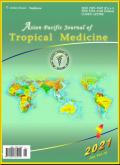2070年之前伊朗埃及伊蚊和白纹伊蚊存在的概率建模
IF 1.6
4区 医学
Q3 PUBLIC, ENVIRONMENTAL & OCCUPATIONAL HEALTH
引用次数: 1
摘要
目的:确定埃及伊蚊和白纹伊蚊的适宜生态生境。到20世纪70年代,伊朗的白纹伊蚊将因气候变化而减少。方法:所有与伊蚊空间分布有关的资料。埃及伊蚊和伊蚊。从网上科学网站提取白纹伊蚊全球采集点地理坐标,并录入Excel文件。利用MaxEnt模型在2030年代、2050年代和2070年代的当前和未来气候条件下,评估了气候和环境变量对这些蚊子的影响。结果:该地区最适宜建立Ae。根据模型输出,埃及伊蚊位于伊朗南部和北部沿海地区。拟合的生态位模拟结果。白纹伊蚊表明,在目前的气候条件下,伊朗南半部从东到西,以及北部海岸的部分地区容易出现该物种。未来,一些地区,如吉兰省和戈列斯坦省,将更有可能存在/建立ai。蚊。此外,根据不同的气候变化情景,该物种的适宜栖息地将逐渐向西北和西部转移。全年最湿季节温度(Bio8)和年平均温度(Bio1)是预测该模型最有效的因子。埃及伊蚊和伊蚊。分别排。结论:在伊朗易感地区,应重点开展不同采集方法的昆虫学研究。未来的建模结果也可用于长期规划,以防止这些入侵伊蚊媒介在该国的进入和建立。本文章由计算机程序翻译,如有差异,请以英文原文为准。
Modelling the probability of presence of Aedes aegypti and Aedes albopictus in Iran until 2070
Objective: To determine the suitable ecological habitats of Aedes (Ae.) aegypti and Ae. albopictus in Iran due to climate change by the 2070s. Methods: All data relating to the spatial distribution of Ae. aegypti and Ae. albopictus worldwide, which indicated the geographical coordinates of the collection sites of these mosquitoes, were extracted from online scientific websites and entered into an Excel file. The effect of climatic and environmental variables on these mosquitoes was evaluated using the MaxEnt model in the current and future climatic conditions in the 2030s, 2050s, and 2070s. Results: The most suitable areas for the establishment of Ae. aegypti are located in the southern and northern coastal areas of Iran, based on the model outputs. The modelling result for suitable ecological niches of Ae. albopictus shows that in the current climatic conditions, the southern half of Iran from east to west, and parts of the northern coasts are prone to the presence of this species. In the future, some regions, such as Gilan and Golestan provinces, will have more potential to exist/establish Ae. albopictus. Also, according to the different climate change scenarios, suitable habitats for this species will gradually change to the northwest and west of the country. The temperature of the wettest season of the year (Bio8) and average annual temperature (Bio1) were the most effective factors in predicting the model for Ae. aegypti and Ae. albopictus, respectively. Conclusions: It is required to focus on entomological studies using different collection methods in the vulnerable areas of Iran. The future modelling results can also be used for long-term planning to prevent the entry and establishment of these invasive Aedes vectors in the country.
求助全文
通过发布文献求助,成功后即可免费获取论文全文。
去求助
来源期刊

Asian Pacific journal of tropical medicine
PUBLIC, ENVIRONMENTAL & OCCUPATIONAL HEALTH-TROPICAL MEDICINE
CiteScore
4.00
自引率
9.70%
发文量
1936
审稿时长
3-8 weeks
期刊介绍:
Asian Pacific Journal of Tropical Medicine (ISSN 1995-7645 CODEN: APJTB6), a publication of Editorial office of Hainan Medical University,is a peer-reviewed print + online Monthly journal. The journal''s full text is available online at http://www.apjtm.org/. The journal allows free access (Open Access) to its contents and permits authors to self-archive final accepted version of the articles on any OAI-compliant institutional / subject-based repository.
APJTM aims to provide an academic communicating platform for international physicians, medical scientists, allied health scientists and public health workers, especially those of the Asia-Pacific region and worldwide on tropical medicine, infectious diseases and public health, and to meet the growing challenges of understanding, preventing and controlling the dramatic global emergence and re-emergence of infectious diseases in the Asia-Pacific.
The journal is proud to have an international and diverse editorial board that will assist and facilitate the publication of articles that reflect a global view on tropical medicine, infectious diseases and public health, as well as emphasizing our focus on supporting the needs of public health practitioners. The APJTM will allow us to seek opportunities to work with others who share our aim, and to enhance our work through partnership, and to uphold the standards of our profession and contribute to its advancement.
 求助内容:
求助内容: 应助结果提醒方式:
应助结果提醒方式:


